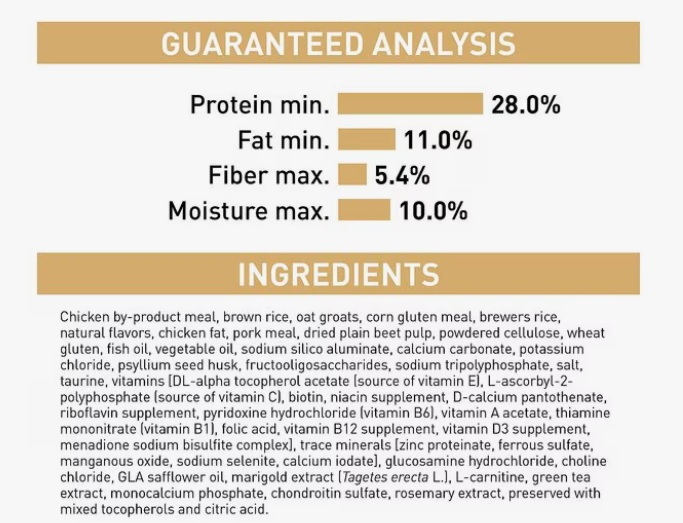How to Choose a Better Kibble for Your Dog
Many dog owners constantly ask, “Is this kibble good?” or “What is the healthiest dry dog food?” or “Which brand should I choose?” But the truth is, it’s not just about the brand. The key to selecting a healthier kibble is understanding what’s inside the bag. By focusing on four main aspects—1) Guaranteed Analysis, 2) Ingredients, 3) Additives, and 4) Added Vitamins & Minerals—you can make a more informed decision. While kibble isn’t the healthiest option, you can still choose better over worse. Let’s break it down.
1. Check the Guaranteed Analysis & Perform the 1-Minute Starch Test
The Guaranteed Analysis on a kibble bag provides crucial information about its nutritional composition. Look for:
- Protein (should be at least 35%)
- Fat
- Fiber
- Moisture
The 1-Minute Starch Check
1️⃣ Find the Guaranteed Analysis on the bag.
2️⃣ Note the percentages for:
- Protein
- Fat
- Fiber
- Moisture
3️⃣ Add these together, then add 6% (estimated minerals).
4️⃣ Subtract the total from 100.
🔢 The Result = Starch Content
Here’s Why This Matters:
Dogs don’t need starch (which is just another word for sugar). Ideally, starch in dog food should be under 10%. Some experts say healthy, active dogs can tolerate up to 20%, but anything higher? It’s a major long-term health risk that could shorten your dog’s lifespan. While it is not so common to find kibble with starches less than 20%, there are still some. Remember, 20% compared to close to 50% in many leading dog food brands is a huge difference
2. Examine the Ingredients List
The ingredients tell the real story of what your dog will be eating. Look for high-quality animal proteins as the first ingredients and avoid harmful fillers.
Good Ingredients:
✅ Named protein sources (e.g., chicken, turkey, beef, salmon)
✅ Healthy carbs from fruits, vegetables, and whole grains (like sweet potatoes, pumpkin, carrots)
Ingredients to Avoid:
❌ Meat by-products and meat meal (low-quality protein sources that don’t specify the source and undergo high-temperature processing). Every additional processing step at high temperatures further strips food of its nutritional value and makes it more dangerous due to the formation of harmful compounds.
❌ High-grain and carbohydrate content (excessive amounts contribute to obesity and other health issues)
❌ Fillers like corn, soy, wheat, peanut hulls, and flours (these offer little to no nutritional value and increase allergy risks)
❌ Soy & soybean derivatives (linked to thyroid issues, allergies, and even cancer)
3. Watch Out for Harmful Additives
Lower-quality kibbles often contain artificial preservatives, colors, and flavors that offer no nutritional benefit and can even be harmful.
Artificial Preservatives to Avoid:
❌ BHA (Butylated Hydroxyanisole) & BHT (Butylated Hydroxytoluene) – These chemical preservatives are linked to cancer and organ toxicity.
❌ Propylene Glycol – Used to retain moisture but is also found in antifreeze.
❌ Ethoxyquin – A pesticide-derived preservative banned in human food but still found in some pet foods.❌ Sodium selenite – A synthetic form of selenium that can be toxic in high doses.
❌ Menadione (Vitamin K3) – A synthetic vitamin linked to toxicity.
❌ Minerals in oxide or sulfate forms (e.g., zinc oxide, copper sulfate) – These are harder for dogs to absorb.
Artificial Colors & Flavors:
❌ Dyes and color additives – Often linked to allergies and behavioral issues.
❌ Artificial flavors – Added to make food taste better but provide no nutritional value.
4. Evaluate Added Vitamins & Minerals
While synthetic vitamins and minerals are common in kibble, excessive or low-quality sources can be harmful.
Red Flags in Added Vitamins & Minerals:
Count the total number of added synthetic vitamins and minerals.
✅ Aim for less than four synthetic vitamins and minerals in the ingredients list.
✅ If that’s not possible, ensure there are no more than eight and that they come from high-quality sources.
Quiz: Let’s See What You’ve Learned!
Ready to put your knowledge to the test? Analyze this dry dog food label (btw, from one of the leading brands, so that it might be healthy?)

👉 What red flags can you spot? 👉 How would you rate this food based on ingredients, guaranteed analysis, additives, and vitamin sources?
You can also grab your dog’s bag of kibble and go through the same checklist. Write your thoughts in the comments or share your findings—I’d love to hear what you discovered!
Conclusion
Choosing the healthiest dry dog food isn’t about brand names—it’s about understanding what’s inside. By checking the Guaranteed Analysis, performing the 1-Minute Starch Test, reviewing ingredients, avoiding harmful additives, and assessing vitamins & minerals, you can make a better choice for your dog’s health. Remember, while kibble isn’t the best option, selecting better over worse can significantly impact your dog’s well-being in the long run.
If you ask yourself why all those brands are making such poor-quality food, read more here (Truth About Pet Food).
If you want to learn more about kibble, how to analyze it, and how to improve your dog’s diet with small or big steps—or explore other feeding options that don’t have to be overly expensive—join my Healthy Dog Nutrition Academy. There, you can ask additional questions and get personalized recommendations for your dog!
